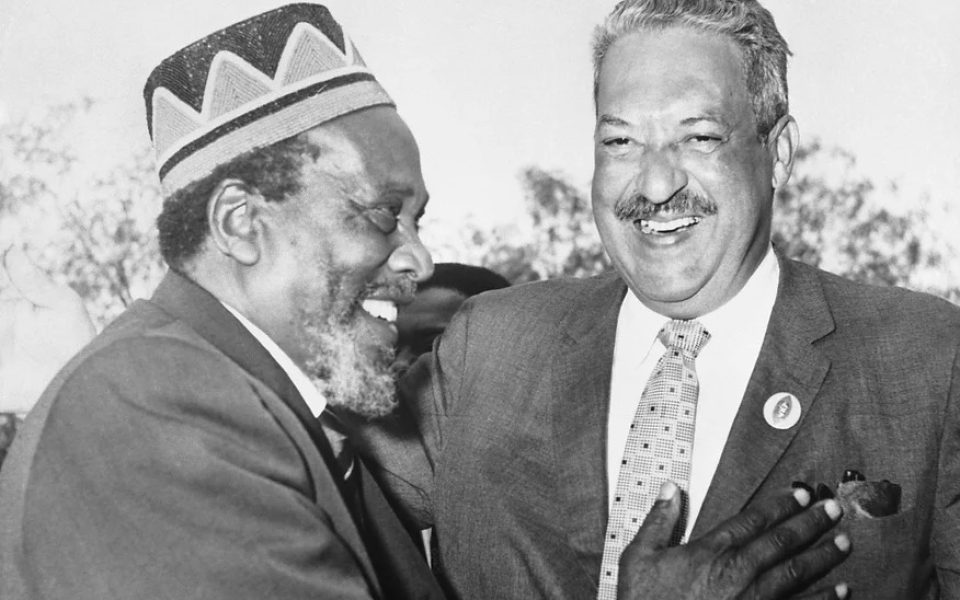Featured photo: Kenyan premier Jomo Kenyatta shares a laugh with Thurgood Marshall in Nairobi, Kenya in 1963. The photo is one of millions of rare images that Getty Images has in its archives. Dozens of these rare images were recently digitized and published in the newly released book, Picturing Black History: Photographs and Stories that Changed the World. (photo courtesy of Bettmann Collection/Getty Images)
Two hundred and twenty feet below ground in a small town called Boyers, Pa., Damarius Johnson found himself surrounded by millions of invaluable pieces of history.
“I was blown away by the images,” says Johnson, a Winston-Salem resident. “I saw the original photo negatives from the March on Washington.”
The freezing cold — -4°F to be exact — underground vaults at the Iron Mountain complex, hold some of the most valuable works in the world, including millions of photos owned by Getty Images. It was within these underground limestone caves that Johnson first started examining many of the images that would be digitized and printed to publish the book, Picturing Black History: Photographs and Stories that Changed the World, released on Nov. 12.
The book, which can be bought at local bookstores, chronicles the achievements of Black figures in American history — those well-known and lesser so — in sharp, crisp photos taken from Getty’s archive along with essays contextualizing the images.

As a graduate student at Ohio State University, Johnson had the unique opportunity to work on this project along with three other co-editors — Daniela Edmeier, Nicholas B. Breyfogle and Steven Conn — to bring the book to fruition.
The idea is a continuation of a website that Getty started in 2020 in conjunction with Ohio State University. In the wake of the George Floyd protests, the company decided to unearth some of its photos that were taken by Black photographers and upload them to a website called picturingblackhistory.org that started the work of identifying photos and adding historical context to them in the form of essays.
While some of the photos on the website may look familiar to viewers, a majority of the shots uncover untold stories of Black life throughout American history from the invention of photography in the late 1800s through 2022. The book puts those into a physical form.
“We looked at maybe 2,000 images,” Johnson says. “We wanted to think about the table of contents to give a lay of what the book might be and ask, ‘What are the stories about Black history that are not well known?’”
In the end, the book identified seven categories of images: portraits of Black history, Black women activists, Black politics, Black culture, Black education, Black America in wartime and the global dimensions of Black history. They also worked to elevate the work of Black photographers, like the cover photo by Barbara DuMetz titled “American Gothic, 1970’s style,” which depicts two individuals staring directly into the camera, the man with glasses and overalls, the woman next to him in a knit sweater, arms crossed, a slight smirk pulling her lips up at the left corner. Johnson says that he is scheduled to interview DuMetz this week and that her story about the cover shot will be featured on the website next year.
One of Johnson’s favorite images in the book shows former Supreme Court Justice Thursgood Marshall laughing alongside the first president of Kenya, Jomo Kenyatta. The shot is unique in Johnson’s eyes not just because there are so few images of Kenyatta laughing, but because the photo connects two social movements: the rising Civil Rights Movement in the US and Kenya’s fight for independence from the British Empire. It shows how many prominent Black political figures were connected to the movements for social justice around the world, and vice versa.

“Black history is a global story,” Johnson says. “There are connections of African Americans to other people in the world, and people around the world are connected to Black history. For this book, we are talking about African Americans, but it’s very important to know that this isn’t the only place in the world that people are resisting oppression, that there is solidarity with other groups who are imagining a better society. Black history isn’t just a story of Black people in this country; it’s a global story, an international story.”
These days, when conservatives have recast teaching Black history as controversial, Johnson says that the best antidote is to show history plainly.
“This book is one of the ways to counter that long tradition of suppressing images related to Black history,” he says.
In addition to choosing images that feature prominent civil rights figures and activists, Johnson says that he and the other editors were intentional about picking photos depicting normal Black life, too. They picked several photos of children, which Johnson says makes the book unique.
“A lot of African-American history is taught about in the activities of adults, but it’s important to think about children,” Johnson says, “because children were at the forefront of integration, and I think elevating Black youth as activists in history is significant.”
Other photos depict more mundane scenes like community events, family gatherings and religious centers. The goal is to show that Black life throughout American history has been a multifaceted and nuanced one, just as it is today.
While the project began several years ago, Johnson says that in the aftermath of the presidential election, a book like Picturing Black History can be a grounding reminder of everything that came before.

“This is one of the reasons why I’m most excited about the book,” Johnson says. “People are always asking this ongoing question: How did we get here, and what do we do about it? In a moment when many people are asking that question, Black history gives context of some of the answers of how they dealt with oppression in their time. In terms of being optimistic, there is a playbook for responding to any political oppression and there is a long history of people standing in solidarity to challenge these oppressions.”
And for Johnson, listening to or reading the stories of history is important, but it’s another thing entirely to be able to see them in photographs.
“It means that in the moment that these events were unfolding, people knew that it would be significant enough to preserve it,” he says. “The photos are proof in and of themselves that they were significant.”
Now, for the first time in history, many of these photos have been uncovered from the underground limestone vaults and will be visible on the pages of this new book. And hopefully they’ll inspire generations to come.
“These photos gave people the encouragement to live everyday life and resist systems that shrunk the possibilities of their lives,” Johnson says. “It’s such a powerful way to demonstrate those stories.”
Order Picturing Black History: Photographs and Stories that Changed the World from Bookmarks in Winston-Salem or Scuppernong Books in Greensboro. Go to picturingblackhistory.org to learn more.
Join the First Amendment Society, a membership that goes directly to funding TCB‘s newsroom.
We believe that reporting can save the world.
The TCB First Amendment Society recognizes the vital role of a free, unfettered press with a bundling of local experiences designed to build community, and unique engagements with our newsroom that will help you understand, and shape, local journalism’s critical role in uplifting the people in our cities.
All revenue goes directly into the newsroom as reporters’ salaries and freelance commissions.


Leave a Reply